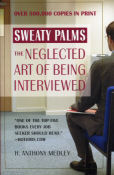| What REALLY goes on in a job interview? Find out in the new revision of "Sweaty Palms: The Neglected Art of Being Interviewed" by Tony Medley, updated for the world of the Internet . Over 500,000 copies in print and the only book on the job interview written by an experienced interviewer, one who has conducted thousands of interviews. This is the truth, not the ivory tower speculations of those who write but have no actual experience. "One of the top five books every job seeker should read," says Hotjobs.com. Click the book to order. Now also available on Kindle. | |
|
Thumbnails Apr 18 by Tony Medley Journey’s End (9/10): Based on a 1928 play by RC Sherriff this captures the ghastliness and bleak despair felt by the soldiers in the trenches of World War I. In 1918 alone more than 1,700,000 combatants were killed. For the entire war (4+ years) about 10% of all fighting soldiers were killed. This compares with 4.5% in World War II. The total proportion of troops who became casualties (killed or wounded) was a staggering 56%. This is a brilliant exposition of what life was like in the trenches and the futility of even trying to hope. The combat scenes are so vivid it’s hard to believe anyone could survive. For an indie it has an exceptionally fine cast which includes Sam Claflin, Asa Butterfield, Paul Bettany, Toby Jones and Tom Sturridge. The only movie with which I can compare it is Stanley Kubrick’s Paths of Glory (1957), but that film doesn’t have the outstanding lifelike battle scenes of this one. Gringo (9/10): A throwback to the old days, a good screwball comedy updated to include X-rated language. In fact, star Charlize Thereon said, “When I played Elaine, things came out of her mouth that I never imagined would come out of my mouth. There were a lot of moments during the making of this film where I was completely red in the face and kind of looking at my crew going, ‘Guys, I’m really sorry for saying all this stuff’.” Shot in Chicago, Mexico City, and Veracruz, Mexico, this film combines action with comedy and fine pace. Unlike many new movies, it celebrates color and light, a pleasure to watch. Tomb Raider (7/10): Raiders of the lost Ark (1981) on steroids, instead of Harrison Ford running and chasing and being chased all the time, this time it’s Alicia Vikander. She’s a lot easier to look at for almost two hours than Harrison, at least for men she is. While the tale has little cohesion, it’s a far, far better film than last year’s silly Wonder Woman. Basically, it’s another exciting, entertaining film for which you must follow The Beatles’ suggestion and simply “turn off your mind, relax and float downstream…” The Death of Stalin (6/10): It’s too bad that this is played for laughs, showing Stalin’s associates as akin to Keystone Kops completely discombobulated by his death, because it would have made a terrific serious movie filled with intrigue and tension. While it gets some things right, like the fate of NKVD Chief Lavrenti Beria, the movie just accepts the story that the monster Stalin (who killed more people than Hitler, including murdering his closest associates) died of a stroke and never raises the possibility that he was assassinated by his comrades (as he probably assassinated Lenin). Satire or farce, it completely missed the mark for me. Final Portrait (2/10): I was expecting something along the lines of “My Dinner with Andre” (1981), but this is nothing as stimulating as that. Writer-director Stanley Tucci must have wanted to capture the tedium involved in sitting for a portrait for a famous artist. So he created a movie as tedious to sit through as it was for James Lord to sit for a painting in 1964 for the artist Alberto Giacometti (a painting that eventually sold for $20 million). The Young Karl Marx Le Jeune Karl Marx (2/10): Director and cowriter Raoul (I Am Not Your Negro) Peck created this tale using the actual correspondence among the people involved including voluminous letters between youthful Karl Marx and Friedrich Engels themselves. It should have been a fascinating story about them as young, vibrant men between the years 1843-50 sans the long Herman Melville-type beards with which they are always pictured. Unfortunately, what Peck has produced is slow and disappointingly uninvolving.
|
|
|
|
|
